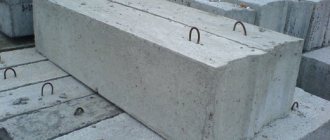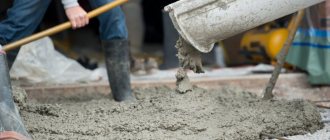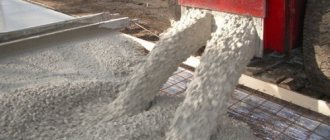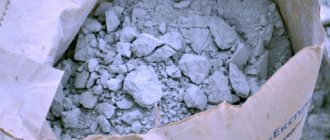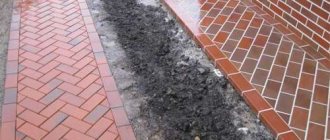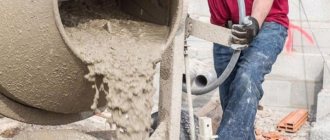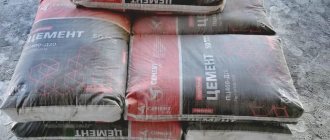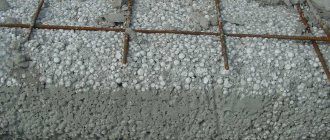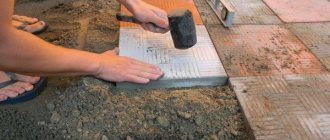For gluing earthenware or porcelain products, we recommend the following composition. Take 125 g of fresh, good quality cottage cheese and wash it with water, squeezing it hard until the flowing water becomes light.
Then the cottage cheese, washed in this way and well squeezed, is placed in a porcelain mortar, the whites of 3 eggs and the juice squeezed from 7-8 heads of garlic are added.
All this is ground well in a mortar, after which finely crushed burnt lime is added little by little until the whole mixture turns into a stiff solid mass.
In this form, the resulting composition is ready for use and stored in a well-sealed jar with a wide neck. To glue some broken porcelain or earthenware object with it, a small amount of it is lightly moistened with water, the surface of the fracture is evenly covered with it and, having quickly fastened the broken parts together, the composition is allowed to dry completely in the dark.
According to evidence, objects made of porcelain or earthenware glued with this composition can withstand fire and boiling water well.
Cement for amber
Here is a simple and good way to glue broken amber things (mouthpieces, etc.). Prepare a weak solution of caustic potassium in water, moisten the surface of the amber to be glued with this solution, and then, after slightly heating it, firmly press the broken parts together.
The latter are glued very firmly, and if the parts fit well, not even the slightest trace remains in the gluing areas.
Cement for gluing celluloid products
In view of the widespread use of celluloid, which allows imitation (fake) of ivory, turtle, coral, etc., it will be useful to indicate a simple and easy way to glue broken things from this composition.
It is enough to moisten the fractures with acetic acid or essence, then, pressing them tightly together, keep them that way. for a while. If the fracture surface fits well, the parts stick together very firmly.
The action of acetic acid is based on the dissolution of celluloid in places of wetting, which then hardens again and thus the fractures are glued together.
How to give Portland cement the property of resisting severe frost
The experiments carried out in this direction by the Austrian engineer Reinhofer deserve attention.
It turns out that an aqueous solution of soda completely protects Portland cement from the harmful effects of extreme cold on its properties.
For the experiments, a lime mortar was prepared from 1 part by volume Portland cement, 1 part lime and 3 parts sand. An aqueous solution of soda is added to this mixture
in such a way that for every liter of cement there is 1 kg of soda dissolved in 3 liters of water.
The lime putty prepared in this way was exposed to a low temperature of 32oC for 14.5 hours, and then dried for 3 hours, and at the same time the cement completely retained its qualities, without detecting the slightest change.
Hence the obvious conclusion, which is of great importance for practice: filling with Portland cement can be done even in severe frosts, without fear of the negative effects of the latter, if an aqueous solution of soda (sodium carbonate) is added to the cement in a proportion close to the above.
Cement for attaching knives and forks to handles
Many different formulations are recommended for this. The simplest method of attachment is as follows: fill all the holes in the handle with rosin powder and, after heating the metal rod of a knife or fork, insert it into the hole; The rosin powder that melts in this case, cools, hardens and holds the knife or fork in the handle quite firmly.
But with this fastening, knives and forks cannot be washed in hot water. In this regard, the following compositions give more satisfactory results: prepare a mixture of 1 part by weight of wax with 3 parts of rosin and, having filled the hole in the handle with this mixture, insert knives and forks. In the same way, the following compositions are used in a hot molten state: to 2 parts by weight of molten shellac, add 1 part of tempered chalk or fuse together 8 parts of rosin, 2 parts of wax and 4 parts of crocus.
Especially for metal handles, the following composition is recommended: 3 parts sulfur are fused in 5 parts rosin and 1 part ceresin (mineral wax). When the mixture melts into a homogeneous mass, add to it, stirring well, 2 parts of brick, crushed into a fine powder. This hot mass is used to fill the holes and insert knives and forks. With this composition, knives and forks are held in the handles very firmly.
Restoring the color of knife and fork cuttings
The black color of the handles of knives and forks can be restored by wiping them several times with iron sulfate. If this remedy turns out to be ineffective, you can moisten the cuttings with a tannin solution and wipe dry with newsprint.
Color
The usual color of cement is dark or light gray. Some types may already have a different shade (magnesian and silicate) during production. They are naturally white. Some of the cement is painted graphite, almost black. This is due to the presence of additional components and dyes. Colored cement is less common.
Cement is colored in two ways: directly during production (a more reliable and economical method) and using pigmented powder during dilution of the solution. Loose pigment makes it possible to paint the mixture in any color, be it red, blue or purple. But such variety is required in exceptional cases, when the cement coating is also decorative.
When using colored cement, it is important to consider that the addition of coloring pigments is insignificant, but still affects its technical characteristics. This mainly affects the shrinkage of the solution. It is more pronounced than that of an uncolored substance.
We invite you to familiarize yourself with Do-it-yourself lime whitening
Cement for pottery
The gluing method is as follows. Place 3-4 pieces of sugar into the dish to be repaired, pour water over them and place on high heat.
When the sugar turns into syrup, pour it over the crack several times, continuing to keep the dish on the fire. Penetrating into the pores, the syrup chars and forms a kind of cement that completely fills the crack.
The charred mass formed in the crack does not impart any foreign taste to the food!
We recommend this method mainly for chemical laboratories, where clay flasks often crack from strong fire. But the same method is quite suitable for household use in relation to earthenware used for cooking food.
The crack is repaired in this way so firmly that the repaired dishes can serve as well as new ones.
Basic performance qualities of cement M400
Portland cement of the described brand is a rather complex composition of mineral components that are in a solid state of aggregation, with a mass fraction of up to 98%. There are aluminum oxides, calcium, magnesium and iron oxides, silicon compounds and other components. In accordance with state standard 31108-2003, Portland cement M400 must have the following basic operational parameters:
- compressive strength after 28 days - more than 30 MPa;
- the setting period of the mixture is more than 60 minutes. upon reaching 98% strength on the 28th day of hardening;
- density with loosened consistency - 1000-1200 kg/m. cubic;
- complete thawing/freezing cycles - at least 70 at an operating temperature range of -60 - +300 degrees C;
- cement that has fully reached its final density must have guaranteed water resistance.
Under storage conditions recommended by the manufacturer (sealed packaging), the material should not lose its working qualities for at least a year.
Glycerin cement
The method of preparing this cement is the simplest.
Lead litharge is taken and ground most carefully into the finest powder, which is then dried in an oven at high temperature and mixed with glycerin until a liquid mass is obtained with the same consistency as Portland cement.
Cement prepared in this way can not only replace Portland cement in all cases without exception, but also surpasses it in its hardness and resistance.
Glycerin cement hardens quickly in air and water; absolutely impermeable to moisture; When hardened, its volume almost does not change at all, due to which this cement does not give the slightest cracks or the slightest holes.
Glycerin cement is not afraid of temperatures, even very high ones, which can be judged by the fact that, as experiments have shown, it can withstand heating up to 300°C without any change.
Finally, another excellent property of glycerin cement: it very firmly glues various kinds of objects from porcelain, earthenware, simple clay, etc., and the glued parts are not afraid of even hot water or high temperatures in general.
In a word, glycerin cement, due to its excellent qualities, represents the “ideal of cements”.
Main Product Features
The starting materials for production are solid minerals, near which cement factories are located. Carbonate stones and clays are used in the production of clinker - a product of joint firing of rocks. The first category of mineral formations is consumed in larger quantities and is represented by limestone varieties of amorphous or crystalline structure, these are:
- chalk is a soft, white rock consisting of calcium carbonate with an admixture of magnesium, metal oxides and quartz grains;
- marl is a natural mixture of 50-75% calcite derivatives with 25-50% silicate clay formations, well suited for the production of cement clinker;
- shell rock is limestone from the shells of marine animals, its variety metamorphosed by pressure at high temperatures is called marble;
- dolomite - in addition to calcium carbonate CaCO3, it contains a magnesium component: MgCO3.
Cement density indicators: bulk - 900-1100 kg/m³, with compaction - 1400-1700. The true specific gravity values reach 3 t/m³. There are several technical characteristics by which the quality of binder powder is judged:
- The fineness of grinding determines the activity of the cement: the smaller the particles, the larger the surface they cover in one layer. Control measurements are performed by scattering on a sieve with a mesh size of 80 microns.
- Water requirement is the amount of moisture required to hydrate the cement and make the dough plastic. Excess water in the solution leads to the formation of pores and cracks, reducing strength.
- Frost resistance is the ability of products based on cement powder to withstand repeated freezing and thawing without destruction. The required indicator is achieved with special additives when mixing the solution.
- Setting time - depending on the thickness of the batch, is in the range of 0.7-10 hours. The indicator also depends on the amount of gypsum added to the clinker during grinding.
- Strength is determined by the destruction of a sample made of cement from each batch of released mortar. The age of the cubes is set by the standard - 28 days.
Main characteristics.
For all volumes shipped by the cement plant, quality certificates are filled out, which include the listed characteristics. Consumers independently carry out incoming inspection to confirm the integrity of the supplier.
Chinese cement Chio-Liao
A method for preparing one of the best and most remarkable Chinese cements, equally suitable for gluing leather, marble, plaster, as well as earthenware, porcelain and other products, has recently been discovered.
The method of preparing this cement is very simple: 54 parts by weight of slaked lime are mixed with 6 parts by weight of alum powder; then 40 parts by weight of well-beaten fresh blood (for example, calf, pig, chicken) are added to them, after which the whole mixture is thoroughly ground until a completely uniform mass of dough-like consistency is obtained.
In this form, cement is used for gluing products made from the above materials.
In a more liquid state, it can serve as a paint for coating objects that are desired to be durable and waterproof. Two or three layers of this composition, sequentially applied to cardboard, are absolutely enough to give the latter the strength of wood.
Storage
There are several methods and options for storing dry cement:
- At home. It is by no means the most reliable way to keep the material suitable for construction and repair. A common mistake is to think that in a warm living room it is dry enough for cement and it does not need additional protection. This is especially true for craft packaging. Even in a house there may be too much air humidity, causing cement to lose some of its characteristics. And if water gets on it, then it begins to clump in the packaging. Also, its operational condition is affected by interaction with oxygen. It is a catalyst for many elements. Its effect on cement also reduces quality characteristics.
- On the street. Here all the dangers are obvious: exposure to environmental factors can ruin the material in less than six months. Of course, it will not stop becoming a viscous substance when water is added, unless the entire bag hardens, but poor storage conditions affect the main quality of the material - its activity. These are its actual fastening properties and compliance with the brand. Damaged cement, at best, will lose 10-15%, and instead of M300 it will behave like the unsuitable M200.
- Spring and summer. In the warm season, cement is threatened by high humidity, exposure to ultraviolet radiation from direct sunlight, and the risk of a greenhouse effect under polyethylene.
We invite you to familiarize yourself with the Medium bell: planting, care, growing from seeds
- In winter and autumn there is a risk of precipitation, and for some mixtures severe frosts and temperature changes are harmful. Even before turning into a liquid solution, cement already loses its beneficial qualities.
- In bags (paper or propylene). Both paper and polypropylene are capable of allowing moisture to pass through, so any container needs additional protection.
- In bulk. The most problematic option for long-term storage. Bulk cement is a dry powder that is delivered to the buyer in sealed containers, and then simply poured into one pile without any container for storage. It requires a special approach, and it is better to order such cement immediately before starting construction or repairs.
The approximate shelf life of cement under favorable conditions is 1.5-2 years. To prevent it from losing its important qualities during different storage methods, it is important to follow the recommendations of professionals. It is advisable to purchase cement immediately before use in the amount that will be needed over several uses.
If for some reason construction work was interrupted and only a small amount of cement remained, it can be stored at home. A suitable room should be dry, away from rooms where water is constantly used (not a balcony or loggia, not a basement), and ventilated. From time to time the bags need to be turned over so that the cement does not cake.
Fragile packaging can be protected with thick bags for construction waste (made of PVC film). It is not advisable to pour it over if the storage period exceeds 6 months, since chemical reactions occur in the open air. The room temperature should not exceed 20-25 degrees to avoid a greenhouse effect inside the package. Condensation can also damage the material.
A large supply of material is difficult to place in a living room; it will have to be taken outside.
To protect it from dampness, you need:
- choose the dryest possible place;
- cover the base (soil, floor) with PVC film in one layer so that the substance does not absorb moisture from the soil;
- place wooden pallets on top. It is advisable to treat the pallets with a primer and varnish or paint, since wood is also highly absorbent. In the future they will come in handy on the farm more than once;
- Wrap each bag with cling film;
- place in especially strong 120-liter garbage bags, seal the top with mounting tape;
- insulate with old clothes, hay or sawdust;
- place under a shed or in an outbuilding. In this form, the cement will be preserved for several seasons without losing its properties.
Bulk cement is stored in so-called cement pits. Organizing them will take a lot of time and effort. It is necessary to dig a deep hole, reinforce its walls so that they do not crumble, take care of several layers of waterproofing and high-quality thermal insulation, and organize a canopy. Mineral wool, foil sheets and PVC film for these purposes will cost no less than a new batch of cement, so loose building materials are not purchased in advance.
Cement for gluing various minerals
A good composition for gluing various minerals (granite or similar stones) can be putty made from lead white, mastic and wax.
It is prepared as follows: take 1 part white lead in the form of tiles for 6 parts by weight of mastic and grind both into the finest powder. Then, having dissolved the white wax over low heat, add the powder little by little, constantly stirring the mixture thoroughly.
When the entire amount of mastic powder and whitewash is dissolved in the melted wax and the whole mass is well mixed to a homogeneous consistency, then the putty is quite suitable for gluing stones. It is not difficult to give this putty one color or another, depending on the color of the stones being glued; To do this, part of the white is replaced with dry, powdered paint of the corresponding color.
This putty very firmly glues various stones and is quite suitable for fixing especially small objects.
Cement for stones and slabs
The best compositions for cementing stones and slabs are considered to be the following: 1 part by weight of resin and sulfur, melted in separate vessels, mixed together and added to the resulting mixture, stirring constantly, 3 parts of lead litharge and 2 parts of crushed sand. Sand and litharge are pre-dried and thoroughly crushed.
Also a good cement is a mixture of 1 part by weight of sulfur, the same amount of pitch (coal tar pitch) and 1/10 part of wax. This mixture is melted and 2 parts of crushed brick are added to it.
To cement sand slabs with this composition or fill grooves with them, the slabs must first be well dried, and the surfaces filled with cement must be lubricated with drying oil.
The use of the above compositions is especially beneficial in cases where stones are exposed to extreme heat or cold, as well as rain or snow. Under such conditions, these compositions give, as experience has shown, incomparably better results than advertised cement of different brands.
Manufacturing and packaging
The production and packaging of cement is a long process that requires high-tech equipment and control.
Its origin lies in limestone quarries. Two types of limestone are used. The first is located close to the surface, at a depth of several tens of centimeters. This is the so-called “second-grade” limestone, but it already contains iron, aluminum oxide, silicon and other minerals. They give cement mixtures unique properties. Both types are used in production, both pure and combined in different proportions with each other and additional components. The ratio of first-class and second-class substances, as well as the type and amount of additives determine the brand and cost of cement. Limestone rock in its natural state is a solid monolith.
At the plant, the raw materials first go to the “primary crusher”. In it, large fragments are crushed to the size of a tennis ball. In the process of grinding large fragments, water enters the crusher so that dust does not rise, and along with it the mass of limestone is not lost. The crushed stones are conveyed through a conveyor to the secondary crusher. In it, the rock is “grinded” into fragments the size of crushed stone. The first and second grades are crushed separately.
Then a raw mixture for cement of different grades is formed. After mixing, the finished “heaps” are sent to a roller mill. In the process of grinding limestone, additives are used: powdered magnesium, silicon and aluminum oxide, if they are contained in the limestone rock in insufficient quantities.
In the heater, unnecessary components are separated, leaving lime suitable for construction. It goes into a cylindrical firebox. The bottom of the firebox warms up to 1700 degrees. The mass inside the kiln is fused into small "glass" balls called clinkers. When leaving the oven, they are quickly cooled with a stream of cold air to 70-80 degrees. Fast is the key. If cooling occurs slowly, the mixture will be of poor quality. This is the raw material for high-quality cement.
The cooled “glass balls” undergo the last stage of processing – final crushing. In fact, this is the grinding of solid clinkers between steel balls of different diameters, of which there are about one and a half tons in one crusher. When grinding clinkers, lump gypsum is added to stone flour. It slows down the hardening process of liquid cement mortar. The powder mixture coming out of the crusher is cement. Some manufacturers add plasticizers to increase strength.
Bags of cement rarely have a small volume of 10-15 kg. Typically, the minimum weight is 25 kilograms, and the most popular is 50 kg. Bags of 50 kilograms are called slimbags. Sometimes there are non-standard volumes of 30, 35, 42, 46 kg. The packaging bag consists of several layers (from 2 to 5) of craft paper.
Big bags have a number of advantages over regular packaging:
- Wholesale purchase of cement reduces the price per 1 kg of mixture;
- soft containers have slings for loading;
- they are heavy-duty, reusable and recyclable;
- the polypropylene shell extends the shelf life because it protects the cement from the negative influence of the external environment;
- containers can be equipped with liners for heat resistance, antistatic, waterproof, and UV protection.
Cement for gluing broken whetstones
First of all, you need to thoroughly wash the broken pieces to remove dirt and grease in alkaline water. After this, the parts that should be in contact are carefully sprinkled with shellac and heated on the stove until the shellac melts and fills the pores.
Heating should be done on a smooth plate, and the flame should not touch the pieces, otherwise they may crack elsewhere. For the same reason, they should not be overheated. When the shellac has melted, the pieces are put together, pressed one on top of the other and left clamped in the clamp until the glued pieces cool.
The pieces connected in this way are so firmly glued to each other that they are not inferior to a whole whetstone.
A well-executed gluing leaves no traces.
Varieties
The term "grey powdery substance" is not entirely true for cement. It also comes in other colors. Its color is given by various additives and colors that affect its technical characteristics. In addition to shades, the material differs according to other criteria. Classification is made according to the component composition, purpose, appearance of the powder and solution, and country of origin.
By composition and properties we can distinguish:
- Sulfate-resistant mixtures. They are obtained by grinding clinkers, but without adding mineral components. Also, during the production of such cement, 90-92% of calcium aluminates are removed from the composition. They are added to concrete when a substance is needed that will be evenly distributed in the pores of concrete without causing internal resistance.
- Portland cement. On the contrary, a large amount of powdered minerals is introduced into it. The result is a fast-hardening, durable layer. The strength of the layer is normalized not only for the “ripened” substance in the fourth week, but also on the third day. This contributes to the fact that when cement hardens, it acquires greater strength and resistance to damage. It does not crack and can withstand various mechanical shocks and loads. Such mixtures are added to the concrete composition in the manufacture of reinforced concrete structures. They are also used in house construction.
- With PAD additives. These include synthetic substances and plasticizers, the amount of which can reach three tenths of the total mass. They are necessary for the absorption of cement sand, that is, they envelop each cement grain with a film that does not allow the substance to adhere to each other. As a result, both the cement mortar itself and its connection with concrete acquire elasticity and are easier to lay and level on the working surface.
- Hydrosulfoaluminate. This fast-drying cement is often called expansive cement due to its ability to expand in volume during the “setting” process. This happens due to the fact that calcium sulfate aluminates are added to the dry mixture, which, as a result of reaction with water, increase in volume by one and a half to 2.5 times (relative to the original solid). When dried, the mass increases by 2%. Despite this “yeasty” effect, it has good density.
- Gypsum alumina or tensile cement. The same as self-expanding, only the component composition in it changes. What it is is clear from the name of the material.
We invite you to familiarize yourself with Larch Krejci Mutation
- Aluminous. The name of this type of cement is telling. It is obtained from limestone, which is laid close to clay deposits in the soil. During the burning and grinding process, a large amount of limestone rock with a share of alumina is added to the mixture. It, in turn, contains aluminates, which transform cement into a fast-hardening viscous substance with hydraulic properties. This product is unique in its technical characteristics. It is used in rare cases when it is necessary to carry out urgent repair work in conditions of high humidity, precipitation, or sub-zero temperatures. Aluminous cement is not capricious in this regard and is equally effective under different conditions. This determines its high cost.
- Hydrophobic. It is obtained by grinding mineral clinkers with various additives. Suitable water-repellent substances, such as asidol (extracted from the processing of kerosene, solar and oily waste from oil production with the addition of sulfuric acid). The use of soda soaps and mineral oils, oleic acid, and fatty acids of synthetic origin is common.
- Shrink-free. It is a mixture of three components: gypsum, lime and aluminous limestone. Semi-hydrous gypsum is used, slaked lime. During the drying process it does not expand or shrink. They are used in the construction of building foundations and tunnel tracks.
- Magnesian. They are obtained in a radically different way from the production of conventional cement. These are compounds of magnesium oxide and an aqueous solution of magnesium chloride. This mixture is heated only to 800 degrees Celsius, and then, when it hardens into a solid white mass, it is crushed. This cement is similar in properties to gypsum and is used more for interior decoration, floor leveling and architectural purposes.
- Pozzolanic. To produce it, active minerals (burnt clay, fuel ash) are added to stone flour from clinkers. These materials are readily available and cheap, and their share in the composition of cement is significant, so the cost of the total mass is lower than for “pure” cement. In solid form, it is resistant to washout and leaching by water. Area of application: underwater and underground structures. Hardened cement must be in an aqueous environment or on the surface all the time, without the variable influence of moisture.
- Silicate. Anyone who has dental fillings is intimately familiar with this material. A fine mixture with a large composition of sodium and calcium fluorides is used in dentistry. Its structure is very similar to tooth enamel. Water is not used as a liquid; special formulations are needed to dilute it. It can be diluted with water for use in interior finishing work as a material for decorative finishing. The cost of such cement is very high.
- Polycarboxylate. A substance with a high level of adhesion to organic tissues. Like silicate cement, it has little to do with construction and is used for medical purposes. In particular, for filling baby teeth.
- Slag. Powder mixture of cement, gypsum and blast furnace slag. The share of slag accounts for from 20 to 60% of the total composition. The more it is, the less active the cement. Its strength increases over time. Resistant to stable aggressive environmental influences, but does not tolerate changes in temperature and humidity levels.
- Lime-slag. In addition to the components of slag cement, it contains a proportion of lime. The strength of the material is not very high, so mortar is used when laying and producing low-grade concrete. Can be added to plaster.
- Backfilling. Its specific area of application is plugging oil and gas wells. The composition contains many components responsible for plasticity, hydrophobicity and high strength.
Cements for gluing glass
Here are the following compositions that can be used for gluing glass objects:
- Take 1 part of caustic lime (in powder), grind it well with 2.5 parts of fresh egg white and then, diluting the mixture with 1 part of water, add 5.5 parts of gypsum, after which the composition is immediately applied to the broken glass. The composition is used only once and is not stored.
- A good composition is also made from carefully squeezed cottage cheese, to which is mixed such an amount of liquid soluble glass (Wasserglas) to obtain a mass with the consistency of honey. This composition is prepared anew every time it is needed.
- Dissolve 10 parts of gelatin over low heat with gentle heating with 15 parts of acetic acid (essence) and add 5 parts of ammonium dichromate, ground into powder, to the resulting solution. The composition is poured into a dark glass jar and stored in a dark room.
- Take 80 parts of white pitch (pitch), boil it until the water is completely boiled away, remove from the heat, mix with it, rubbing well, 12 parts of lard and gradually add red ocher powder until the whole mass has a solid consistency. Cement prepared in this way is heated before use until it becomes soft. The cement hardens quickly and holds tightly.
Cement for gluing glass plates
Ordinary glue is not suitable for such gluing. The following composition turns out to be the best: in a tightly closed vessel, prepare a mixture of 1 part mastic, 0.5 parts ammonia resin, known commercially as gum ammonia, and 6 parts alcohol (85%). The vessel is then placed in a warm room until the mastic and gum ammonia are completely dissolved.
At the same time, another solution is prepared: 2.5 parts of fish glue are doused with 10 parts of alcohol (85-90%) and 15 parts of pre-filtered water. The mixture in a well-closed container is left alone for a day, after which it is heated in a water bath until the glue dissolves.
Then both prepared solutions, slightly heated, are mixed together, filtered through a cloth and the composition is ready for use.
To glue glass plates, their surfaces are first washed with alcohol, wiped dry, then covered with a thin layer of the above composition, placed on top of each other and kept tied until the composition dries.
In this way, the plates are firmly glued together and the glass retains its original transparency.
Cement for sticking glass
Here are two cement recipes. Dissolve 125 g of powdered rosin, 36 g of white wax and 75 g of red lead (kolkotar) over low heat.
Then, when you get a liquid mass, remove the mixture from the heat and carefully (away from the fire!) add 18 g of turpentine (purified turpentine) and stir with a wooden stick until completely cooled, after which the composition is ready for use.
Dissolve 10 parts of common resin with 1 part of yellow wax over a fire and stick the glass onto the metal with the resulting mixture. Can be used for gluing glass when making or repairing aquariums.
Cement for joining broken coals for arc lamps
The putty consists of 12 parts bronze powder and 18 parts soda liquid glass. For the same purpose, you can also use a mixture of 1 part zinc white, 1 part manganese peroxide (in powder) and 1 part liquid glass. You need to add some more well-crushed arc coals to this mixture.
In order to test whether pieces of arc coals have stuck together well, take several glued coals in your hand and listen to whether they ring well when lightly tapped; if it's good, then they can go to work. However, glued coals should not be used immediately; it is better to leave them to dry for half a day.
